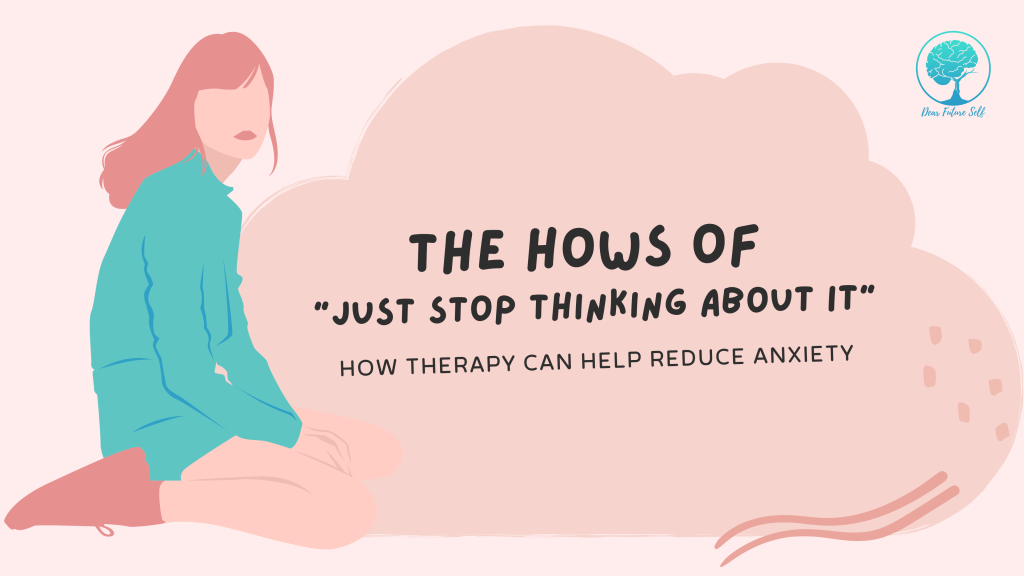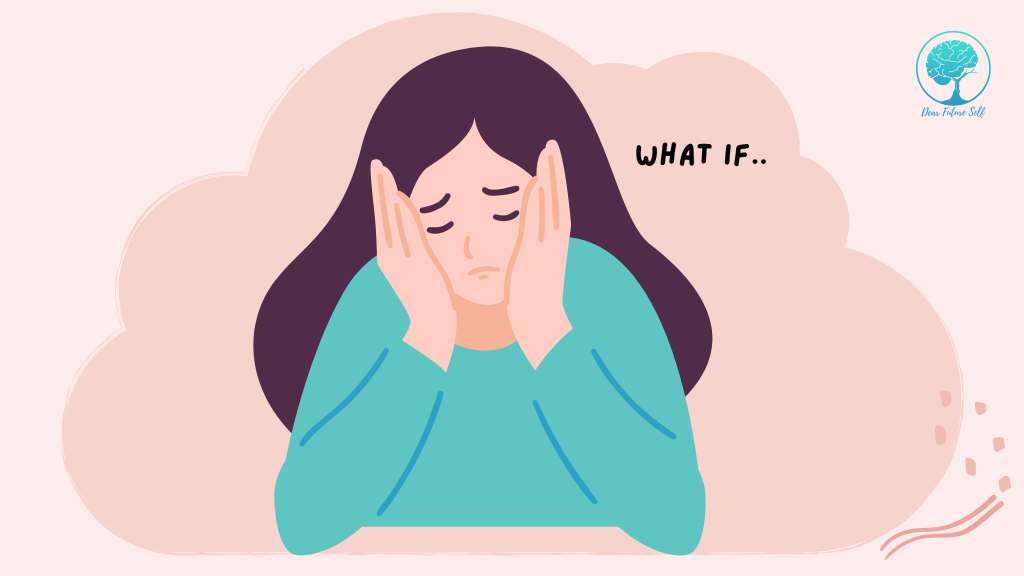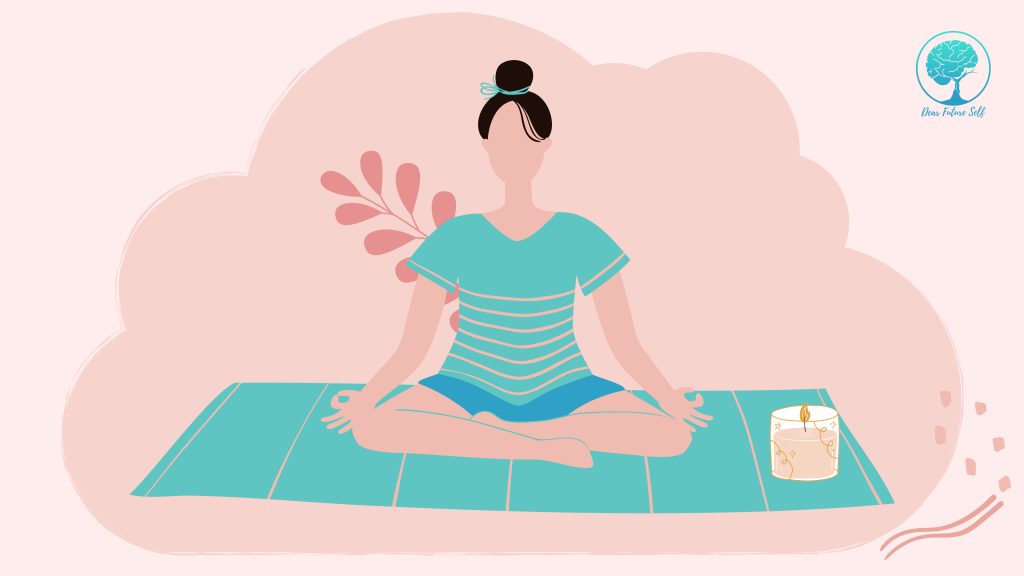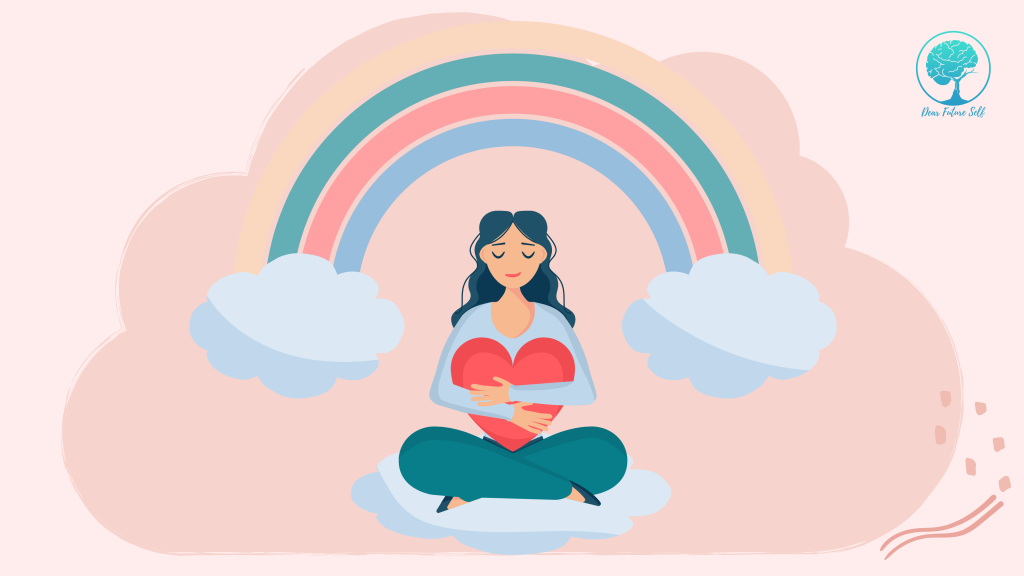
22 Jul The Hows of ‘Just Stop Thinking About It’

How Therapy Can Help Reduce Anxiety
When we or a loved one feels anxious, we overthink and feel overwhelmed about the situation. We sometimes tell ourselves to “Just stop thinking about it”, wishing that statement could make our thoughts and feelings of anxiety vanish. But we know that’s rarely the case. Ironically, the opposite effect usually happens where we end up thinking about the intruding thoughts even more. So what can we do to just stop thinking about it?
Unsurprisingly, therapy can be very helpful to manage and cope with anxiety. But what many people aren’t aware of is what goes on during therapy sessions. It’s not entirely talking about your problems—although that is very important, but also understanding thought patterns, identifying negative thoughts with their causes and origins, and creating treatment plans to change that thought. Overall, there is more than what meets the eye in the process of therapy.
Going deeper into its treatment for anxiety, the therapist will use a framework or an approach that has been backed up by research and studies that is most appropriate for the client they want to help. For instance, Cognitive Behavioral Therapy (CBT) is an approach that helps reduce or change the client’s maladaptive thoughts as it rests on the belief that these cause psychological problems and influences emotions and behavior. Thus, CBT could greatly benefit people with anxiety whose intrusive thoughts not only make them feel fearful and apprehensive, but affect their behavior like actively avoiding many situations.
Specifically, CBT includes some of the following methods:
A. Cognitive Restructuring
Therapists use cognitive techniques to help clients identify and challenge irrational thoughts (aka cognitive distortions) and negative thinking patterns. An example of a cognitive distortion would be catastrophizing or assuming the worst will happen (i.e. “If I do not get good grades, I will be a failure for life”). This may be a frequent thought for someone with anxiety as their brains are on alert for possible threats that could harm them. As such, therapists teach their clients to catch themselves with this thinking and turn their irrational thoughts into more rational ones.
For instance, challenging thoughts and seeing the problem more objectively can help with this transformation. Therapists can teach clients to ask themselves “Were there no successful people in life who got bad grades?”, “Can grades accurately reflect my intelligence, talents, and abilities?”, and “What is my definition of good grades, and is this standard realistic or just puts me under too much pressure?” among others. Clients might also want to recall experiences that made them feel competent, successful, and intelligent. In the end, this not only reduces the image of bad grades as a sure sign of failure in life, but enables the client to generate alternative, compassionate, and accurate thoughts of their situation.
B. Improve Emotional Experience
One form of CBT that therapists use to help clients emotions is called Behavioral Activation which states that behavior affects emotions. For example, when a client feels upset and angry, the therapist may encourage them to engage in hobbies they enjoy such as listening to music, dancing, and doing sports to feel less stress and more relaxed or energized. However, if the client engages in activities that intensify their current feelings such as refusing to take breaks and avoiding or lashing out on people, this reinforces their feelings of anger and sadness, sometimes making them feel worse. Thus, behavioral activation advocates for the idea that “action precedes emotions”. It invites us to move ourselves in activities and situations that make us feel better, even if we don’t feel like doing so.
C. Relaxation as Coping Strategy
A person’s anxiety can manifest in bodily sensations as the sympathetic nervous system—the one responsible for the body’s response to stress-related activities, becomes highly active. There is often rapid breathing or shortness of breath, increased heart rate, trembling, sweating, headaches, and fatigue among others. Additionally, some people who have anxiety experience panic attacks which is a sudden episode where an individual feels extreme apprehension and terror that triggers severe physical reactions.
With this, therapists like to use relaxation techniques to help ease their client’s physical symptoms of anxiety. It is also believed that easing physical symptoms would affect the client’s emotional state of feeling less fearful or apprehensive. One example of relaxation technique would be mindfulness-based therapy that allows the client to focus their mind on themselves, their bodily sensations, and environment. Basically, client’s become mindful of everything that they feel within them and around them which can help them relax and ease anxiety. Furthermore, this is supported by the study of Hofmann et al. (2010) that mindfulness-based therapy has relatively promising effects for the improvement of quality of life of people with anxiety disorders.
Other relaxation techniques can be used as well such as deep breathing exercises, drinking tea or chamomile pastilles, meditation, massages, and many more that is up to the client’s preference on what they can use as a coping strategy for anxiety.
D. Cognitive Behavior Modification
Using behavioral techniques, therapists are able to change maladaptive behavior into a more adaptive one. They can also enhance adaptive behavior to help improve client’s overall well-being. For example, a client who has social anxiety and would like to conquer her fear of social situations could be introduced to exposure, social skills training, and activity scheduling.
Exposure treatment is a core aspect of CBT for social anxiety. Here, the therapist and client make a list of triggers—scenarios and activities that might bring anxiety or fear, then create a hierarchy from this list that brings the most anxiety to the least anxiety. Slowly but surely, the therapist guides the client to conquer her fear of social situations by exposing her to the triggers while processing in between her feelings, thoughts, and behavior.
A therapist can also provide social skills training by role-playing in sessions on what the client could do or say in social situations. The therapist would not only model a behavior to follow, but the client can also practice this with them. Lastly, activity scheduling is another method under CBT which allows the client to add pleasurable and healthy activities they have not tried or normally do into their schedule. This not only helps to improve their mood but lets the client try something new making them feel accomplished, competent, and more open to experiences.
E. Changing Ones Relationship With Dysfunctional Thoughts
Another form of CBT is called Acceptance and Commitment Therapy (ACT) which rests on the belief that worry or negative emotions are not problematic, rather it’s the unwillingness to accept these internal experiences. By becoming more accepting, we start to change our relationship with dysfunctional thoughts and feelings. We realize the importance of acknowledging our thoughts and emotions instead of avoiding them or feeling guilty about it, especially since it is only natural for humans to feel negative emotions. Thus, by being more self-accepting and compassionate to ourselves and our experiences, we steer towards self-healing and start to focus on the things we can change rather than what we cannot.
Overall, the role of Cognitive Behavioral Therapy helps clients change the way they think and better handle triggering thoughts and emotions that provoke anxiety. They are also more effective than just mentioning ‘stop thinking about it’ as we all know it’s not that easy. It’s a longer but logical version of convincing the client’s mind to change. Once they have successfully changed that thought, they will be able to change other negative thoughts, until symptoms of anxieties are eventually also being reduced.
What can you do now to spare your ![]() from anxiety ?
from anxiety ?
References:
Hofmann, S. G., Sawyer, A. T., Witt, A. A., & Oh, D. (2010). The Effect of Mindfulness-Based Therapy on Anxiety and Depression: A Meta-Analytic Review. Journal of Consulting and Clinical Psychology, 78(2), 169–183. https://doi.org/10.1037/a0018555
Stefan, S., Cristea, I., Szentagotai A., & David, D. (2019). Cognitive‐behavioral therapy (CBT) for generalized anxiety disorder: Contrasting various CBT approaches in a randomized clinical trial. Journal of clinical psychology, 2019-07, Vol.75 (7), p.1188-1202.
Self-Help Corner
Seek Professional Help

Gift Certificates & Self-Care Package
Connect with Us








